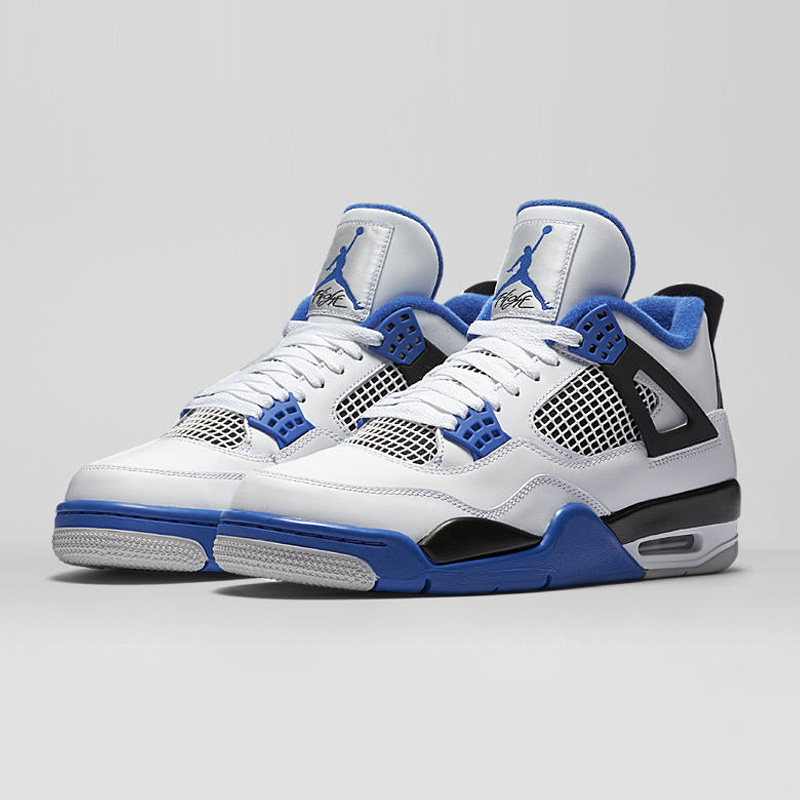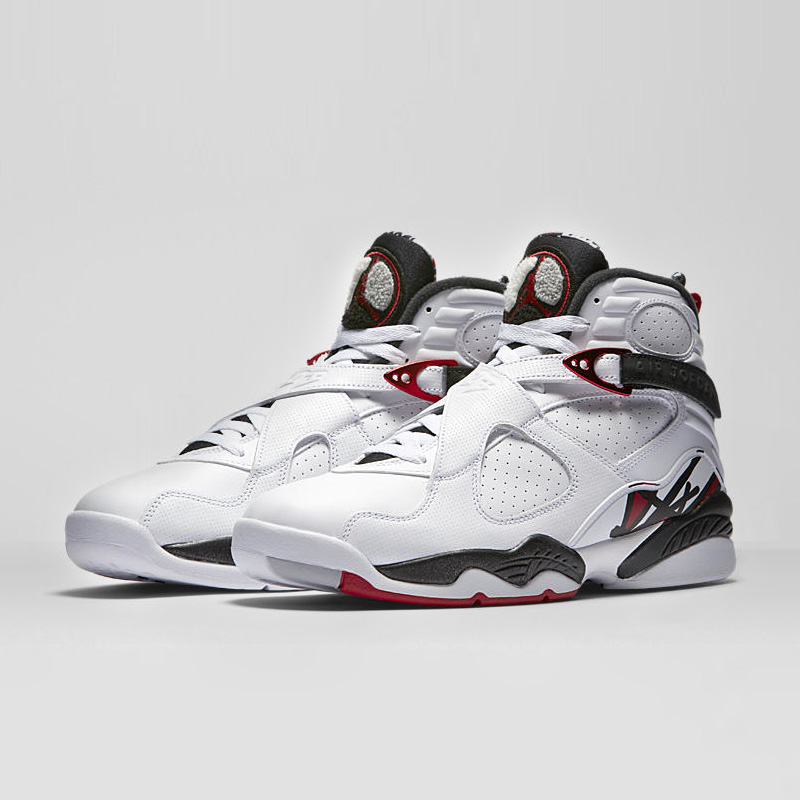
 #WEAREJORDAN
#WEAREJORDANChanging the game both on and off the court, the Air Jordan brand is still as popular as it has been since the early 80's and continues to be a household name.
THE JORDAN STORY
In 1984, Nike signed a young Michael Jordan to a lucrative contract over five years. This was considered to be a huge risk at the time. Jordan was an unproven rookie but, Nike was confident in Jordan's abilities, appeal and potential so the deal was made.
In April of 1985, the first Jordan commercial was aired, "Jordan Flight". By the time Air Jordans hit the shelves in April of 1985, supply could not meet the demand. Jordan commented on the success by saying, "What Phil & Nike have done is turn me into a dream." This was just the beginning...
In 1984, Nike signed a young Michael Jordan to a lucrative contract over five years. This was considered to be a huge risk at the time. Jordan was an unproven rookie but, Nike was confident in Jordan's abilities, appeal and potential so the deal was made.
In April of 1985, the first Jordan commercial was aired, "Jordan Flight". By the time Air Jordans hit the shelves in April of 1985, supply could not meet the demand. Jordan commented on the success by saying, "What Phil & Nike have done is turn me into a dream." This was just the beginning...
Key Stats
Led the Chicago Bulls to six NBA championships (1991, 1992, 1993, 1996, 1997, 1998)
Five-time NBA Most Valuable Player and six-time NBA Finals MVP
Played in 1,072 NBA games, scored 32,292 points, and had 5,633 assists and 6,672 rebounds
Led the Chicago Bulls to six NBA championships (1991, 1992, 1993, 1996, 1997, 1998)
Five-time NBA Most Valuable Player and six-time NBA Finals MVP
Played in 1,072 NBA games, scored 32,292 points, and had 5,633 assists and 6,672 rebounds
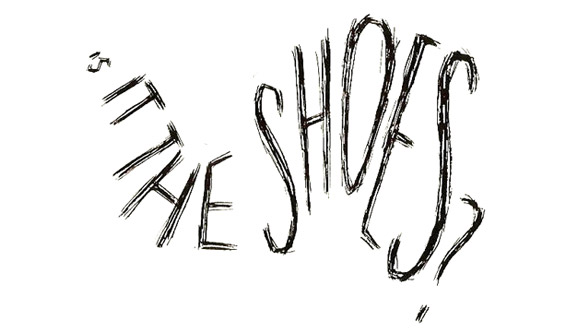
TIME TO TAKE FLIGHT 1 TO 31
Since the release of the first model back in 1985, the Air Jordan annual reveal has become a monumental affair. Eagerly awaited by ball players to sneakerheads, who have helped the Air Jordan to be one of the most successful athletic shoe series of all time.
Since the release of the first model back in 1985, the Air Jordan annual reveal has become a monumental affair. Eagerly awaited by ball players to sneakerheads, who have helped the Air Jordan to be one of the most successful athletic shoe series of all time.
NEWS & RELEASES
JORDAN 1 'BLACK METALLIC GOLD WHITE' - launching 10.01
The Air Jordan 1 is back with similar details to the recent Top 3 release. Featuring a black tumbled leather upper, gold trimmings and not forgetting the LA city map on its insole.
SHOP JORDAN
The Air Jordan 1 is back with similar details to the recent Top 3 release. Featuring a black tumbled leather upper, gold trimmings and not forgetting the LA city map on its insole.
SHOP JORDAN
SIGN UP FOR RELEASE UPDATES

AIR JORDAN I
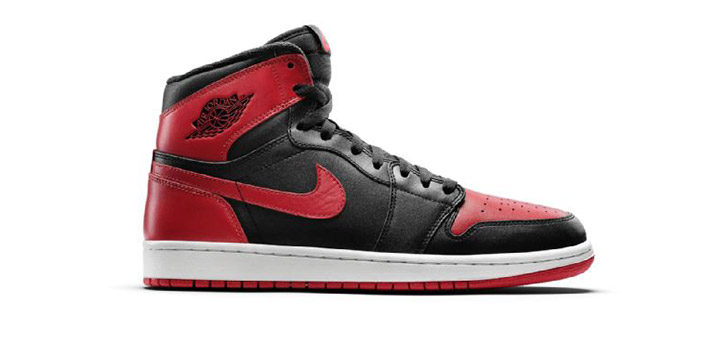
1985
This model retailed at $65, when released for the first time in '85 and was labeled 'the most expensive basketball shoe on the market'
Jordan was fined $5,000 for every game he wore these by the NBA because of rules regarding shoe colourways.
This model retailed at $65, when released for the first time in '85 and was labeled 'the most expensive basketball shoe on the market'
Jordan was fined $5,000 for every game he wore these by the NBA because of rules regarding shoe colourways.
Designed by then-Nike creative director Peter Moore, the Air Jordan I technically had an Air-Sole incorporated in its design, but the use of the technology was minimal at best.
The real innovation came in its colors. The red/black/white colorway caught the attention of the NBA, which forced Nike to alter it. The Air Jordan went a long way in reviving Nike's sagging profits, and helped make Michael Jordan a star.
The real innovation came in its colors. The red/black/white colorway caught the attention of the NBA, which forced Nike to alter it. The Air Jordan went a long way in reviving Nike's sagging profits, and helped make Michael Jordan a star.

AIR JORDAN II
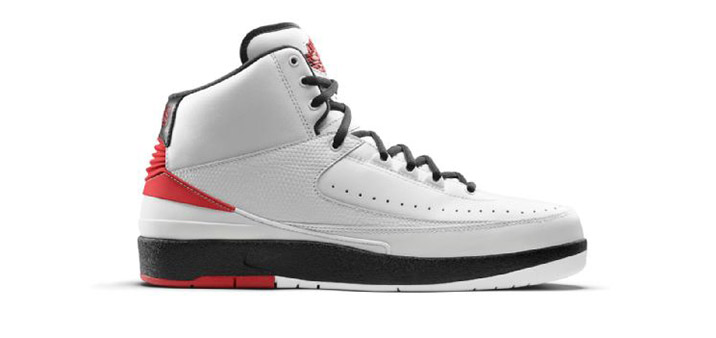
1987
Bruce Kilgore was responsible for designing the classic Nike Air Force 1
Whilst wearing this model, Michael managed to win his first NBA Slam Dunk contest going against the likes of Jerome Kersey, Terence Stansbury, Clyde Drexler, Ron Harper, to name a few.
Bruce Kilgore was responsible for designing the classic Nike Air Force 1
Whilst wearing this model, Michael managed to win his first NBA Slam Dunk contest going against the likes of Jerome Kersey, Terence Stansbury, Clyde Drexler, Ron Harper, to name a few.
Bruce Kilgore took the lead design on the Air Jordan II, which was made in Italy and intended to be a more upscale choice for consumers. It is notable for not featuring the Swoosh prominently on the side of the shoe, and was the last to use the Wings logo. The Air Jordan II included a full-length, encapsulated Air unit, which provided far better cushioning than the previous model. The Air Jordan II was initially released in November of 1986.

AIR JORDAN III

1988
The first model to bear the Jumpman logo replacing the wings
Spike Lee writer/actor/director, got in on the action by appearing in a TV commercial for the shoe as the Mars Blackmon character alongside Michael
The first model to bear the Jumpman logo replacing the wings
Spike Lee writer/actor/director, got in on the action by appearing in a TV commercial for the shoe as the Mars Blackmon character alongside Michael
Designed by Tinker Hatfield, the Air Jordan III was a slam dunk in the marketplace.
Adopted from the Air Revolution, another Nike basketball shoe, the Air Jordan III was the first mid-top in the line, used synthetic "elephant print" leather for added comfort and was the first to include visible Nike Air.
Adopted from the Air Revolution, another Nike basketball shoe, the Air Jordan III was the first mid-top in the line, used synthetic "elephant print" leather for added comfort and was the first to include visible Nike Air.

AIR JORDAN IV

1989
Designed by Tinker Hatfield Nike retroed the Air Jordan IV in 1999, ten years after its first release
This model made a big appearance in Spike Lee's film 'Do The Right Thing'
Designed by Tinker Hatfield Nike retroed the Air Jordan IV in 1999, ten years after its first release
This model made a big appearance in Spike Lee's film 'Do The Right Thing'
Hatfield used "overmolded mesh," or mesh that was dipped in plastic and hardened, which made the shoe breathable and lightweight but didn't cheapen its look and feel.
Hatfield also developed a multi-port lacing system consisting of two plastic tabs with nine ports each, so consumers could lace up in 18 different positions.
Hatfield also developed a multi-port lacing system consisting of two plastic tabs with nine ports each, so consumers could lace up in 18 different positions.

AIR JORDAN V

1990
Designer Tinker Hatfield took inspiration from WWII Mustang fighter planes
The phrase "Is It The Shoes" became poplar through Spike Lee's character Mars Blackmon, in more collabrotive TV commercial for the shoe
Designer Tinker Hatfield took inspiration from WWII Mustang fighter planes
The phrase "Is It The Shoes" became poplar through Spike Lee's character Mars Blackmon, in more collabrotive TV commercial for the shoe
Featuring new design elements such as a fit-enhancing lace lock, a reflective tongue (so the Jumpman logo would pop when hit by a flash) and clear outsoles, which designer Tinker Hatfield thought to incorporate after designing the shoes for Back To The Future II.

AIR JORDAN VI

1991
Michael won his first NBA Championship ring wearing the Air Jordan VI
Tinker Hatfield designed this model using the Batman boots wore in film 'Batman Returns' as inspiration
Michael won his first NBA Championship ring wearing the Air Jordan VI
Tinker Hatfield designed this model using the Batman boots wore in film 'Batman Returns' as inspiration
A bit taller than its predecessors, it featured a tall rubber tongue that helped the consumer get in the shoe. Designer Hatfield incorporated the clear outsoles and lace locks from the Air Jordan V. This model was the first to utilize Michael Jordan's preference for a clean toe, without a tip. The is the last shoe to proclaim "Nike Air," and shows the Jumpman in a more prominent position--all part of Hatfield's plan to de-emphasize the Swoosh.

AIR JORDAN VII

1992
Michael Jordan wore the Olympic - inspired colourway of this shoe at the 1992 summer games in Barcelona, leading the USA team to a gold model
The VII design removed the to visible Air unit
Michael Jordan wore the Olympic - inspired colourway of this shoe at the 1992 summer games in Barcelona, leading the USA team to a gold model
The VII design removed the to visible Air unit
Using aspects of Huarache technology, such as an inner bootie, and the lack of a visible Air-Sole, the Air Jordan VII was a more stripped-back design than some of its predecessors. Most prominently, it is the first in the line to not display a Swoosh outside. The shoe incorporates a West African Tribal motif, which was inspired by a poster that designer Tinker Hatfield saw in a record store.

AIR JORDAN VIII

1993
2007 saw a re-released of the Aqua colourway, which Michael wore in the 1993 NBA All-Star game
This was designed by Tinker Hatfield and was inspired by baroque design
2007 saw a re-released of the Aqua colourway, which Michael wore in the 1993 NBA All-Star game
This was designed by Tinker Hatfield and was inspired by baroque design
One of the heavier in the line to date, as well as one of the loudest. Inspired by baroque design, the Air Jordan VIII was the first to feature anti-inversion crossover leather/velcro straps, a polycarbonate torsion plate, and thickened padding.
Designer Tinker Hatfield has said it wasn't one of his favorite shoes, admitting it was a bit over the top.
Designer Tinker Hatfield has said it wasn't one of his favorite shoes, admitting it was a bit over the top.

AIR JORDAN XI
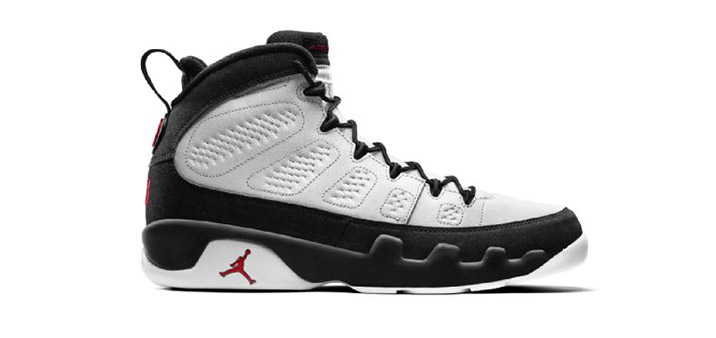
1994
The back of the shoe resembles the rising sun
LeBron James wore a St. Vincent St. Mary's colourway of this shoe during his 2003 high school senior year
The back of the shoe resembles the rising sun
LeBron James wore a St. Vincent St. Mary's colourway of this shoe during his 2003 high school senior year
The Air Jordan IX featured a Japanese-inspired design and a multi-language outsole that spells out Jordan's qualities in French, Spanish, Italian, German, Russian and Swahili.
This model was released after Jordan's first retirement, and this is the only one he didn't play in during his days with the Bulls. It was, however, redesigned as a baseball cleat.
This model was released after Jordan's first retirement, and this is the only one he didn't play in during his days with the Bulls. It was, however, redesigned as a baseball cleat.

AIR JORDAN X

1995
Worn by Michael when he returned to the NBA
Wearing these, Michael scored 55 points whilst beating the New York Knicks in Madison Square Garden
Eight colourways contributed to being a part of the City Serie
Worn by Michael when he returned to the NBA
Wearing these, Michael scored 55 points whilst beating the New York Knicks in Madison Square Garden
Eight colourways contributed to being a part of the City Serie
Michael Jordan returned to the NBA on March 19, 1995, against the Indiana Pacers. He wore the "Chicago" colorway of the Air Jordan X.
The X featured a padded collar, pull tab at the heel and an elastic band lacing system. The midsole of the X was constructed of lightweight Phylon connected to a rubber outsole. The outsole listed Jordan's career achievements on alternating stripes.
The X featured a padded collar, pull tab at the heel and an elastic band lacing system. The midsole of the X was constructed of lightweight Phylon connected to a rubber outsole. The outsole listed Jordan's career achievements on alternating stripes.

AIR JORDAN XI
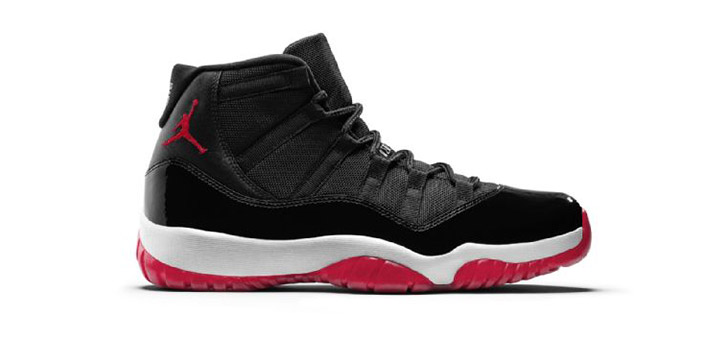
1996
Designed by Tinker Hatfield, and remains his favourite of the Jordan line
The inspirations of the AJ XI include; a lawnmower, mountaineering backpack an a convertible car
Designed by Tinker Hatfield, and remains his favourite of the Jordan line
The inspirations of the AJ XI include; a lawnmower, mountaineering backpack an a convertible car
This model debuted several breakthroughs, most notably the carbon fiber plate for lightweight rigidity and the use of patent leather, which Hatfield found on a Japanese baseball player's shoe.
Hatfield created the shoe while Jordan was retired, and used several inspirations on it.
Hatfield created the shoe while Jordan was retired, and used several inspirations on it.

AIR JORDAN XII
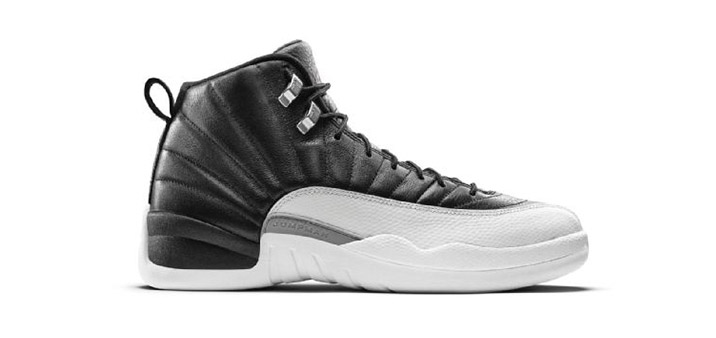
1997
Despite suffering from the flu, Michael wore these whilst managing to score 38 points and beating the Utah Jazz to win his fifth NBA title
The shoe features faux reptile print on the side of the toe
Despite suffering from the flu, Michael wore these whilst managing to score 38 points and beating the Utah Jazz to win his fifth NBA title
The shoe features faux reptile print on the side of the toe
This Nike Air Jordan XII is signed by Michael Jordan. With inspiration coming from a woman's high heel shoe, the Air Jordan XII was the first in the franchise to incorporate Zoom Air, the first that was built purposefully asymmetrical and the first in the Brand Jordan family, using the tagline, "Inspired By The Greatest Player Ever." It utilized an improved carbon fiber shank, but was designed to be more subdued and upscale.

AIR JORDAN XIII
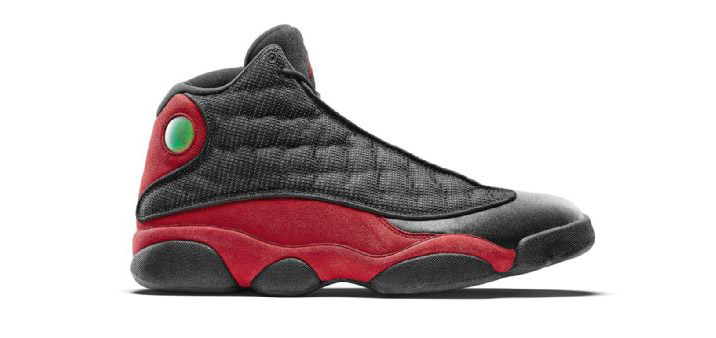
1998
Tinker Hatfield overall inspiration comes from a Black Panther, using the hologram on the upper heel to represent the panthers eye
Originally released in five mid colourways and two low colours
Tinker Hatfield overall inspiration comes from a Black Panther, using the hologram on the upper heel to represent the panthers eye
Originally released in five mid colourways and two low colours
Featuring a paw-like outsole and a hologram on the ankle intended to resemble a cat's eye, the Air Jordan XIII was inspired by Jordan's cat-like quickness. Unknown to designer Tinker Hatfield, Jordan's close friends called him "black cat," making this a perfect match up.
The AJ XIII features Zoom Air and a carbon fiber spring plate.
The AJ XIII features Zoom Air and a carbon fiber spring plate.

AIR JORDAN XIV

1999
This was re-released in 2005 and 2006 in 10 total colourways
Michael managed to make the "Last Shot" over Bryon Russell to beat the Utah Jazz to and win his sixth NBA Championship
This was re-released in 2005 and 2006 in 10 total colourways
Michael managed to make the "Last Shot" over Bryon Russell to beat the Utah Jazz to and win his sixth NBA Championship
Created by Tinker Hatfield and Mark Smith, the Air Jordan XIV was inspired by Jordan's car, the sleek Ferrari 550 M.
The Jumpman logo makes several appearances and can be seen on the metal lace tips, outsole, insole, back heel, toe and side heel.
The Jumpman logo makes several appearances and can be seen on the metal lace tips, outsole, insole, back heel, toe and side heel.

AIR JORDAN XV
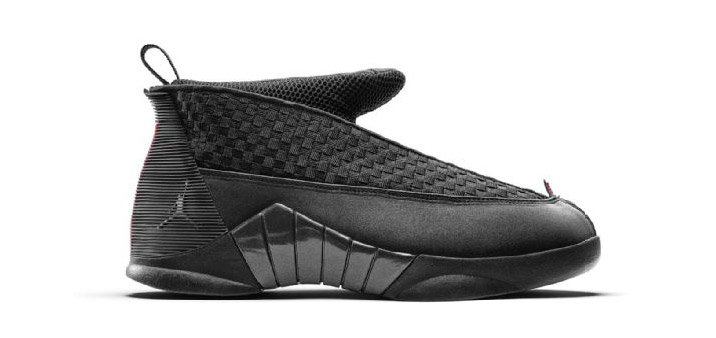
2000
The Air Jordan XV marked the last shoe in a 12-year run for designer Tinker Hatfield
Four colourways were released in 1999-2000
The Air Jordan XV marked the last shoe in a 12-year run for designer Tinker Hatfield
Four colourways were released in 1999-2000
A narrow, aerodynamic look, the Air Jordan XV was inspired by the X-15 fighter jet. It includes a woven upper, and is inscribed with "23/6/15/2/17" for Jordan's jersey number, championships won, the model number and his birthday.
The AJXV features hidden speed lacing system, seamless dynamic-fit sleeve, rubber herringbone traction pods, an injected TPR external heel counter and a breathable leather pattern
The AJXV features hidden speed lacing system, seamless dynamic-fit sleeve, rubber herringbone traction pods, an injected TPR external heel counter and a breathable leather pattern

AIR JORDAN XVI
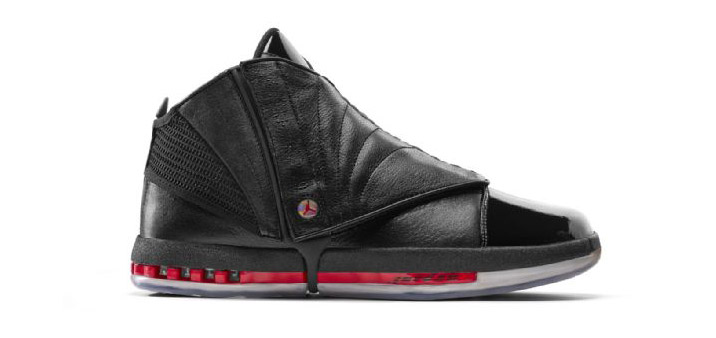
2001
Designed by Wilson Smith III, and was inspired by Michael's transition from player to executive
Brand Jordan adverts saw Michael sporting a suit with the AJ XVI, which some say our 'one of the most stylish off-court Air Jordans'
Designed by Wilson Smith III, and was inspired by Michael's transition from player to executive
Brand Jordan adverts saw Michael sporting a suit with the AJ XVI, which some say our 'one of the most stylish off-court Air Jordans'
The first Air Jordan in 12 years not to feature Tinker Hatfield as lead designer, the Air Jordan XVI featured several returns to form: visible Air, patent leather and a clear sole.
Designed by senior designer Wilson Smith, the shoe looked forward as well, with a removable shroud that transformed it from a fashion shoe to a game shoe - similar to Jordan's move from the court to the boardroom.
Designed by senior designer Wilson Smith, the shoe looked forward as well, with a removable shroud that transformed it from a fashion shoe to a game shoe - similar to Jordan's move from the court to the boardroom.

AIR JORDAN XVII

2002
The most expensive Air Jordan ever produced, with a suggested retail price of $200
Jordan scored his 30,000th point against the Chicago Bulls while wearing the Air Jordan XVII
The most expensive Air Jordan ever produced, with a suggested retail price of $200
Jordan scored his 30,000th point against the Chicago Bulls while wearing the Air Jordan XVII
The Air Jordan XVII released in 2002 was designed by Nike veteran Wilson Smith,
who used several inspirations to create the shoe. They included Jazz, which is expressed through notes on the shoe shroud in a nod to a song written by saxophonist Mike Phillips. Zaha Hadid, an architect whose futuristic and fractal styles is evident in the shoe's translucent midsole. And The Aston Martin, Jordan's car of choice.

AIR JORDAN XVIII
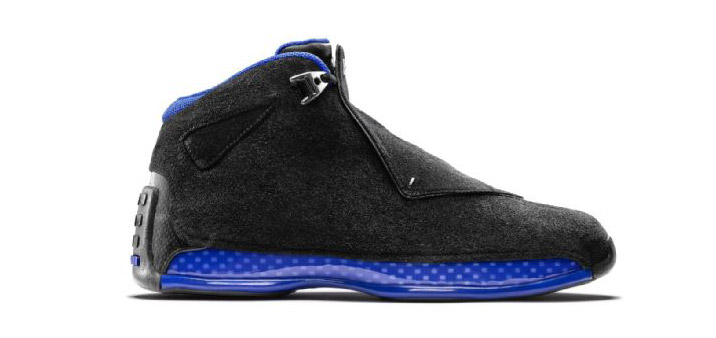
2003
Inspired by Italian race cars, and designed by Tate Kuerbis
Michael wore the White and Royal colourway during his final game in April 16th 2003
Inspired by Italian race cars, and designed by Tate Kuerbis
Michael wore the White and Royal colourway during his final game in April 16th 2003
Using a virtual one-piece upper, as well as a patented carbon fiber Comfort Control Plate and dual-layer Zoom Air technology.
It was also the first shoe to include a ".5" edition. The 18.5 was designed to be worn during Jordan's final playoff run, but the Washington Wizards didn't make the playoffs. Instead, it became Carmelo Anthony's first game shoe.
It was also the first shoe to include a ".5" edition. The 18.5 was designed to be worn during Jordan's final playoff run, but the Washington Wizards didn't make the playoffs. Instead, it became Carmelo Anthony's first game shoe.

AIR JORDAN III

2004
A collaborative effort, with Senior Designer Tate Kuerbis leading the design - with support from Jason Mayden, Wilson Smith III, Josh Heard and Suzette Henri
A collaborative effort, with Senior Designer Tate Kuerbis leading the design - with support from Jason Mayden, Wilson Smith III, Josh Heard and Suzette Henri
Inspired by the black mamba snake, the lightest, most flexible and most breathable Air Jordan to date included Tech Flex (industrial braided sleeving) on the upper, and a lightweight, flexible and breathable overwrap. It also had double-stacked, full-length Zoom Air.
It was the product of a team of designers, a first for an Air Jordan shoe.
It was the product of a team of designers, a first for an Air Jordan shoe.

AIR JORDAN III

2005
Mark Smith and Tinker Hatfield united for the Air Jordan series 20th Anniversary and designed this shoe
This was the first Air Jordan to feature a midfoot support strap
Mark Smith and Tinker Hatfield united for the Air Jordan series 20th Anniversary and designed this shoe
This was the first Air Jordan to feature a midfoot support strap
Tinker Hatfield returned to design this shoe (his first since the Air Jordan XV), which features an Independent Podular Suspension cushioning system that places 20 columns of phylon across the shoe and an ankle strap, patterned after surfboard leashes, which could be looped around the leg entirely to make a low top, but wrapped around the ankle for a high top. Mosdt noticeably, it includes a complicated mosiac of laser etchings that symbolizes Jordan's life and career.

AIR JORDAN XXI
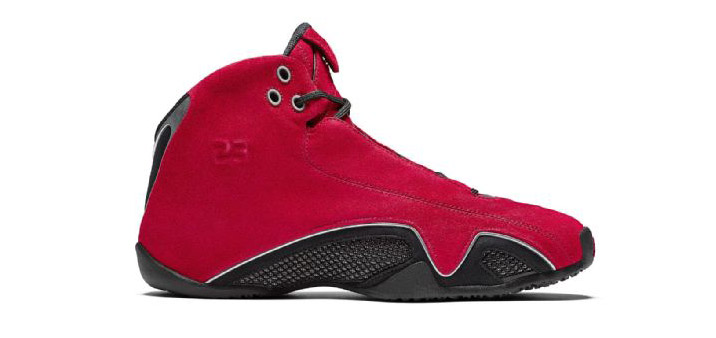
2006
D'Wayne Edwards, the XX1 designer used the Bentley Continental GT coupe as an inspiration point
Only two original colourways of the Air Jordan XX1 released in 2006
D'Wayne Edwards, the XX1 designer used the Bentley Continental GT coupe as an inspiration point
Only two original colourways of the Air Jordan XX1 released in 2006
Designed by D'Wayne Edwards, the Air Jordan XXI's inspiration came from the simple luxury of a Bentley Continental GT. It utilized Independent Podular Suspension technology, which included interchangeable cushioning.
The two interchangeable heel pods (one zoom Air, one encapsulated Air) came with the shoe, so the player could customize the cushioning to his or her specific demands.
The two interchangeable heel pods (one zoom Air, one encapsulated Air) came with the shoe, so the player could customize the cushioning to his or her specific demands.

AIR JORDAN XX2
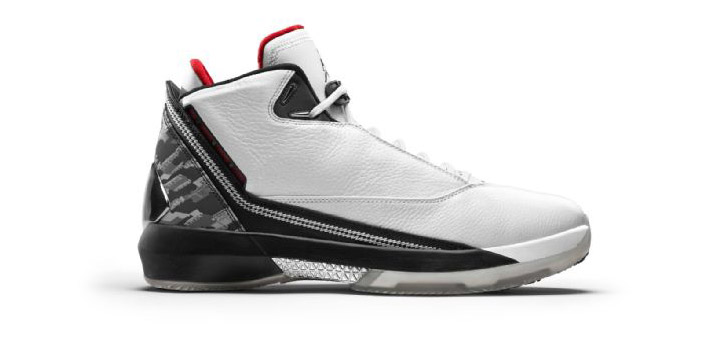
2007
The F-22 Fighter Jet inspired D'Wayne Edwards design of the AJ XX2
Released during the 2007 All-Star weekend on Michael Jordan's 44th birthday, 17th February
The F-22 Fighter Jet inspired D'Wayne Edwards design of the AJ XX2
Released during the 2007 All-Star weekend on Michael Jordan's 44th birthday, 17th February
Inspired by one of the most advanced fighter jets in the world, the F-22 Raptor, the Air Jordan XXII's design features sharp lines and zig-zag stitching. The shoe includes a titanium shank for a stronger, lighter ride, and Independent Podular Suspension, with two removable suspension heel pods for player customization. The shoe was designed by D'Wayne Edwards.

AIR JORDAN XX3
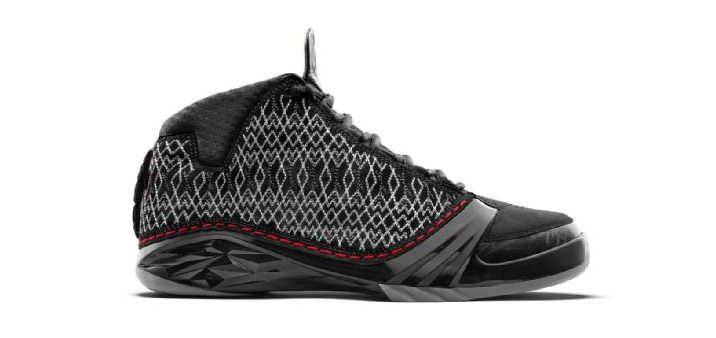
2008
23 pairs of the special Titanium model were released at the top 23 locations in the United States, retailing for $230
The XX3 was worn in NBA All-Star game by Carmelo Anthony, Ray Allen and Chris Paul
23 pairs of the special Titanium model were released at the top 23 locations in the United States, retailing for $230
The XX3 was worn in NBA All-Star game by Carmelo Anthony, Ray Allen and Chris Paul
The Air Jordan XX3 was the first Air Jordan shoe with the Nike Considered tag, meaning it had to perform for pros while also adhering to strict sustainability rules. The shoe was designed by Nike veteran Mark Smith, who enjoyed the Considered challenge.
An example are the interlinked Ms and Js across the upper, which actually hold the shoe together with minimal gluing.
An example are the interlinked Ms and Js across the upper, which actually hold the shoe together with minimal gluing.

AIR JORDAN 2009

2009
Designed by Jordan series veteran Jason Mayden
The split in the heel enhances responsiveness by keeping at least one half of the heel in contact with the ground at all times
Designed by Jordan series veteran Jason Mayden
The split in the heel enhances responsiveness by keeping at least one half of the heel in contact with the ground at all times
The first shoe to use its calendar year release date as opposed to the roman numeral convention, the Air Jordan 2009 is the 24th shoe in the Jordan franchise.
Designed by Jordan veteran Jason Mayden, the shoe introduced Articulated Propulsion Technology, inspired by the carbon fiber prosthetics used by Paralympians and developed to allow an explosive forward movement.
Designed by Jordan veteran Jason Mayden, the shoe introduced Articulated Propulsion Technology, inspired by the carbon fiber prosthetics used by Paralympians and developed to allow an explosive forward movement.

AIR JORDAN 2010

2010
25th Anniversary of the Jordan series, most iconic sneaker line of all time
Tinker Hatfield and Mark Smith collaborate on designing the Air Jordan 2010 that will also be the signature shoe for Dwayne Wade
25th Anniversary of the Jordan series, most iconic sneaker line of all time
Tinker Hatfield and Mark Smith collaborate on designing the Air Jordan 2010 that will also be the signature shoe for Dwayne Wade
Released as the signature sneaker of Dwayne Wade. It was designed by Nike veterans Tinker Hatfield and Mark Smith. The shoe's most striking feature is the thermoplastic urethane (TPU) window, which was the team's response to Jordan's request for a transparent shoe.
The shoe also features a layered toe construction that has an independent forefoot support cover, which mimics a foot's flexibility without restrictive structures.
The shoe also features a layered toe construction that has an independent forefoot support cover, which mimics a foot's flexibility without restrictive structures.

AIR JORDAN 2011

2011
Quality craftsmanship on this shoe to reflect a high-end fashion dress shoe
Tom Luedecke designed this shoe to be performance-focused, with two cushioning insole options
Quality craftsmanship on this shoe to reflect a high-end fashion dress shoe
Tom Luedecke designed this shoe to be performance-focused, with two cushioning insole options
Designed by a team led by Nike veterans Tinker Hatfield and Tom Luedecke, the Air Jordan 2011 is the 26th shoe in the Air Jordan series.
It has a modular approach, allowing players to swap in a midsole with either heel and forefoot Zoom Air Units or one with a 3/4 length Air unit. With hand finished leather, the shoe is designed to reflect high-end dress shoes.
It has a modular approach, allowing players to swap in a midsole with either heel and forefoot Zoom Air Units or one with a 3/4 length Air unit. With hand finished leather, the shoe is designed to reflect high-end dress shoes.

AIR JORDAN 2012

2012
Tinker Hatfield and Tom Luedecke design the AJ 2012 to be a very high-performance
A shape of an 'M' has tight double stitched on the toe-box to acknowledge Michael
Tinker Hatfield and Tom Luedecke design the AJ 2012 to be a very high-performance
A shape of an 'M' has tight double stitched on the toe-box to acknowledge Michael
Featuring two interchangeable inner sleeves and three interchangeable midsoles to offer six different configurations.
Co-designed by Tinker Hatfield and Tom Luedecke, the shoe also features a midfoot plate that is constructed out of a combination of glass and carbon, and contoured to the natural shape of a foot.
Co-designed by Tinker Hatfield and Tom Luedecke, the shoe also features a midfoot plate that is constructed out of a combination of glass and carbon, and contoured to the natural shape of a foot.

AIR JORDAN XX8

2013
A zipper front that folded down neatly to reveal Michael's famous jersey number, 23, '2' on the medial (outside) of one shoe and a '3'
The two years in development of the all-new Jordan Flight Plate mid sole, designed to deflect force and maximize the Zoom Air
A zipper front that folded down neatly to reveal Michael's famous jersey number, 23, '2' on the medial (outside) of one shoe and a '3'
The two years in development of the all-new Jordan Flight Plate mid sole, designed to deflect force and maximize the Zoom Air
The Jordan Flight Plate, which essentially unlocks the Nike Zoom airbags in the forefoot and heel to maximize responsiveness. The most visible element is the synthetic shroud, built partially out of a Swiss fabric used in premium motorcycling jackets.
The Air Jordan XX8 was designed by a team led by Air Jordan franchise figurehead Tinker Hatfield and Jordan veteran Josh Heard.
The Air Jordan XX8 was designed by a team led by Air Jordan franchise figurehead Tinker Hatfield and Jordan veteran Josh Heard.

AIR JORDAN XX9

2014
The AJ XX9 become the lightest Air Jordan ever made
The shoe links the forefoot and heel with a tendril, a small bridge of outsole, for smooth heel-to-toe transition
The AJ XX9 become the lightest Air Jordan ever made
The shoe links the forefoot and heel with a tendril, a small bridge of outsole, for smooth heel-to-toe transition
Designed by longtime Air Jordan designer Tinker Hatfield, who said the woven upper construction was inspired by the woven construction of automobile air bags. It was the first instance in which a woven upper was developed for a performance basketball shoe. Air Jordan XX9 leverages innovative HyperWeave technology to deliver an ultra-lightweight on-court experience.

AIR JORDAN XX9

2015
Each of the shoe's elements results from a key performance insight or design inspiration fundamental to the player and Jordan Brand's evolutions
The Air Jordan XXX is a unique synthesis of Jordan's evolution as a player and a design collaborator
Each of the shoe's elements results from a key performance insight or design inspiration fundamental to the player and Jordan Brand's evolutions
The Air Jordan XXX is a unique synthesis of Jordan's evolution as a player and a design collaborator
An "XXX", signifying 30, transformed into a basketball net. Stars symbolized the athlete's otherworldly talents and planets orbiting the Jordan universe took on surfaces - elephant print or carbon fiber - related to innovations initiated by past Jordan models. Elaborating his drawing, with help of fellow designer Mark Smith, Hatfield broadened the Jordan narrative and formed the story of the Air Jordan XXX, one that references a storied yet timeless lineage with an eye towards the future.































